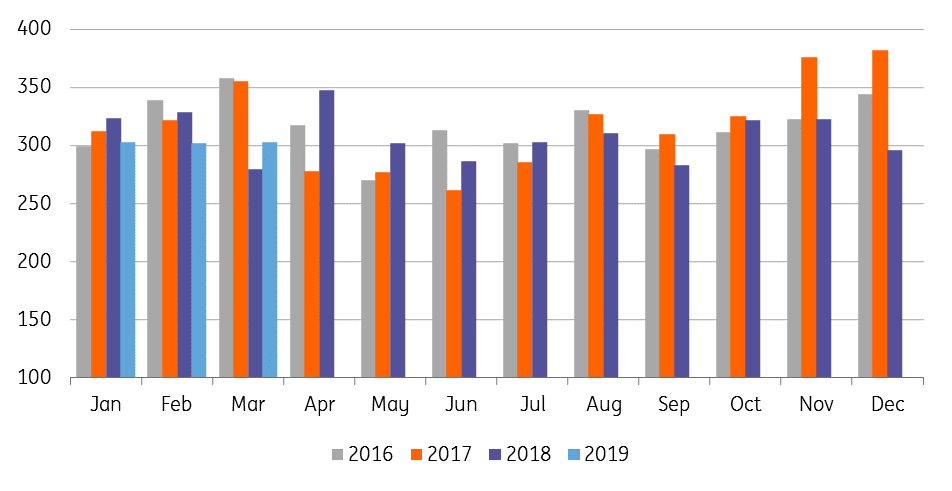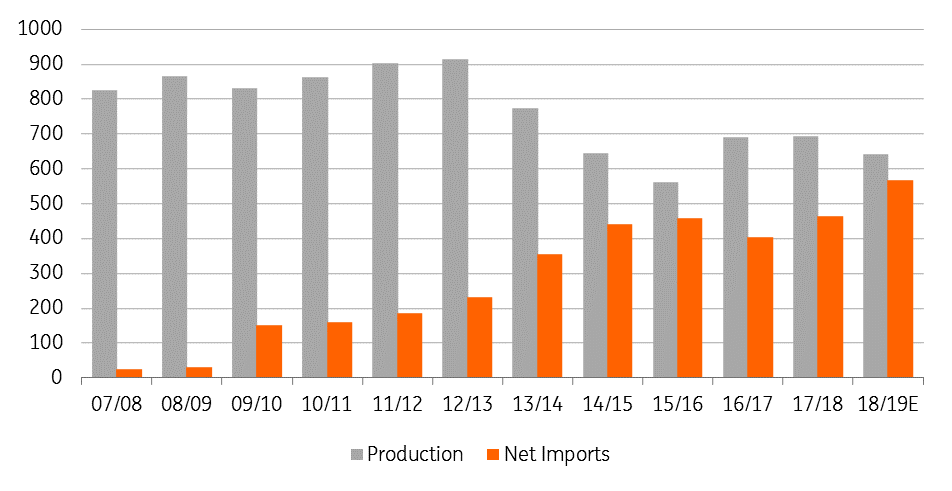Natural rubber: The bounce back
Rallying oil prices, weather-related supply disruptions and export interventions have all been bullish factors for the natural rubber market. However with export intervention a short-term fix, and plenty of uncertainty around demand, the outlook for natural rubber remains fragile
ITRC agreement supports prices...for now
The natural rubber market has seen somewhat of a reversal in fortunes, with TSR20 futures rallying as much as 22% so far this year, a trend that we have seen with a number of commodities this year, particularly the energy complex. Oil prices rallied as much as 35% with OPEC+ members remaining committed to cutting oil output by 1.2MMbbls/d over the first six months of 2019. Moving forward though, the big question is whether OPEC+ will continue with its deal over the second half of this year. We do not believe that the deal will continue in its current form, with the market already expected to be tight over 3Q19, whilst the expiry of waivers for buyers of Iranian oil means the potential for an even tighter oil market. We are of the view that ICE Brent will remain well supported in the region of US$70-75/bbl for the remainder of this year.
However the natural rubber market has had its own reasons to rally this year. The strength in crude oil has certainly played a role but a tropical storm in Thailand and an early wintering season in South East Asia has tightened the market somewhat. Exports from Thailand over the first three months of 2019 totalled 908kt, a 3% decline year-over-year. Cumulative production between Thailand, Indonesia, Malaysia, India and Vietnam totalled 1.88mt in the first two months of 2019, up just 0.7% YoY, according to GAPKINDO data.
Speculation that the International Tripartite Rubber Council (ITRC) would limit natural rubber exports once again provided further upside for the market. The market took comfort when the ITRC confirmed that they would cut exports by 240kt over a four-month period starting April 2019. The agreement sees both Indonesia and Malaysia reducing exports by 98.2kt and 15.6kt, respectively starting 1 April, whilst Thailand will cut shipments by 126.2kt starting 20 May.
However, the issue once again with this action is that it is a short-term fix. The last time we saw the ITRC intervene in the market was back in 1Q18, where the three member countries agreed to cut exports by 350kt for the first three months of the year. While this did provide some support to the market, once the limits were lifted, prices continued to trend lower for much of 2018. It is difficult to see a different scenario this time around, particularly with expectations that global economic growth will slow as we move through the course of this year, although a large part of this will depend on how trade talks between China and the US evolve. At the moment, the trade outlook does not look overly constructive, with the US set to increase tariffs on Chinese goods as soon as this week.
Thai monthly natural rubber exports (k tonnes)

Indian supply recovery?
The picture for the global natural rubber market last year could have looked even gloomier had it not been for India turning to the world market for imports. Over the 2018/19 fiscal year (Apr-Mar) India imported 582kt of natural rubber, a 24% increase YoY. These additional imports were largely a result of a smaller crop following devastating flooding in Kerela, which saw production over the year fall by almost 8% YoY to 642kt, according to India’s Rubber Board.
Assuming that India experiences a normal monsoon this year (early forecasts are pointing towards a normal to drier monsoon), we would expect to see a recovery in Indian domestic output for 2019/20, which should reduce the country’s domestic deficit.
Elsewhere, both Vietnam and Cambodia continue to see strong growth in export flows. Vietnamese exports increased 26.1% YoY to 401kt over the first four months of 2019, adding nearly 75-80kt of rubber to global supply over the period. Meanwhile, Cambodian supplies increased by 10-12kt, with exports rising 23% YoY to 48.2kt in 1Q19. Additional supply from these two growers does partly offset the cuts that we are seeing from ITRC members.
Indian natural rubber production & net imports (k tonnes)

Chinese imports edge lower
Chinese natural rubber imports remain under pressure, with imports over the first quarter of 2019 totalling 470kt, down 16% YoY. This is a trend that we have seen for a while now, with imports over full year 2018 falling by 7% YoY to total 2.6mt. The downward pressure shouldn’t come as too much of a surprise when looking at tyre output in the country. While Chinese output data is fairly distorted at the start of the year owing to the Chinese New Year, tyre production continues to trend lower. Cumulative output over the first three months of this year totalled 187m units- down almost 11% YoY.
Sluggish demand in China continues to see SHFE natural rubber inventories remain at more than comfortable levels. Currently, stocks total almost 431kt, which sits towards the top end of the five-year high for this time of the year.
The data does not get any better when looking at Chinese vehicle sales, which declined for the ninth consecutive month in March, according to China’s Association of Automobile Manufacturers. Sales in March totalled 2.52m, down 5.2% YoY. However the one positive to take away from this is the fact that the YoY declines are narrowing, whilst moving forward expectations are that a reduction in VAT will support sales.
SHFE natural rubber inventories (k tonnes)

Download
Download articleThis publication has been prepared by ING solely for information purposes irrespective of a particular user's means, financial situation or investment objectives. The information does not constitute investment recommendation, and nor is it investment, legal or tax advice or an offer or solicitation to purchase or sell any financial instrument. Read more
